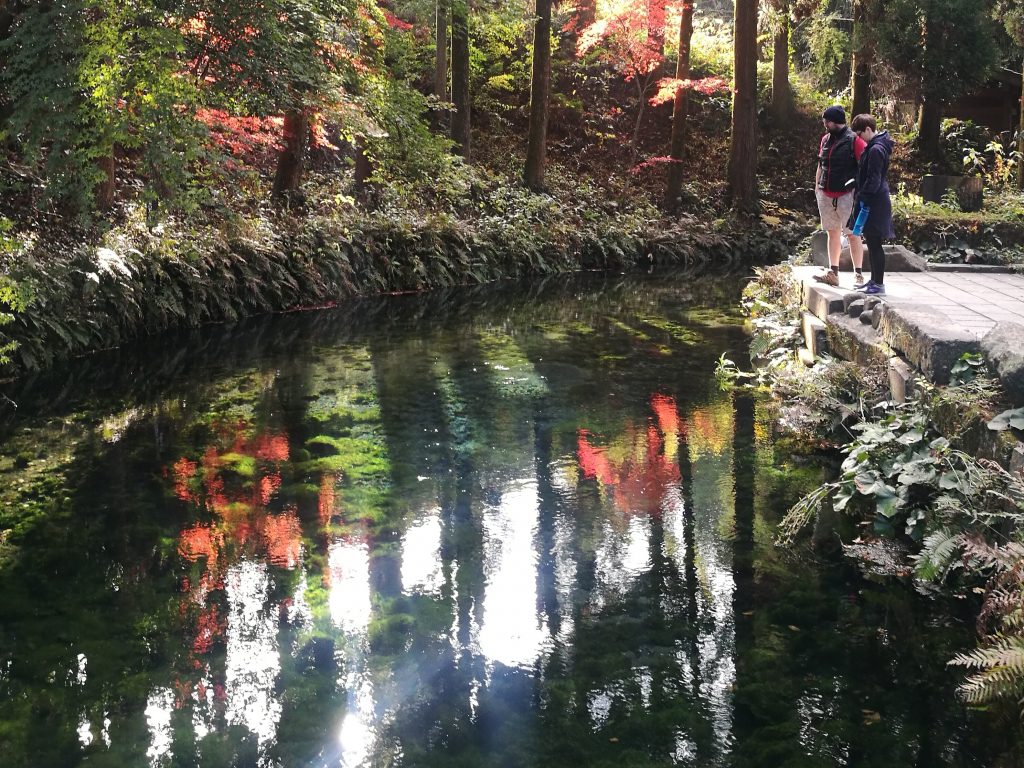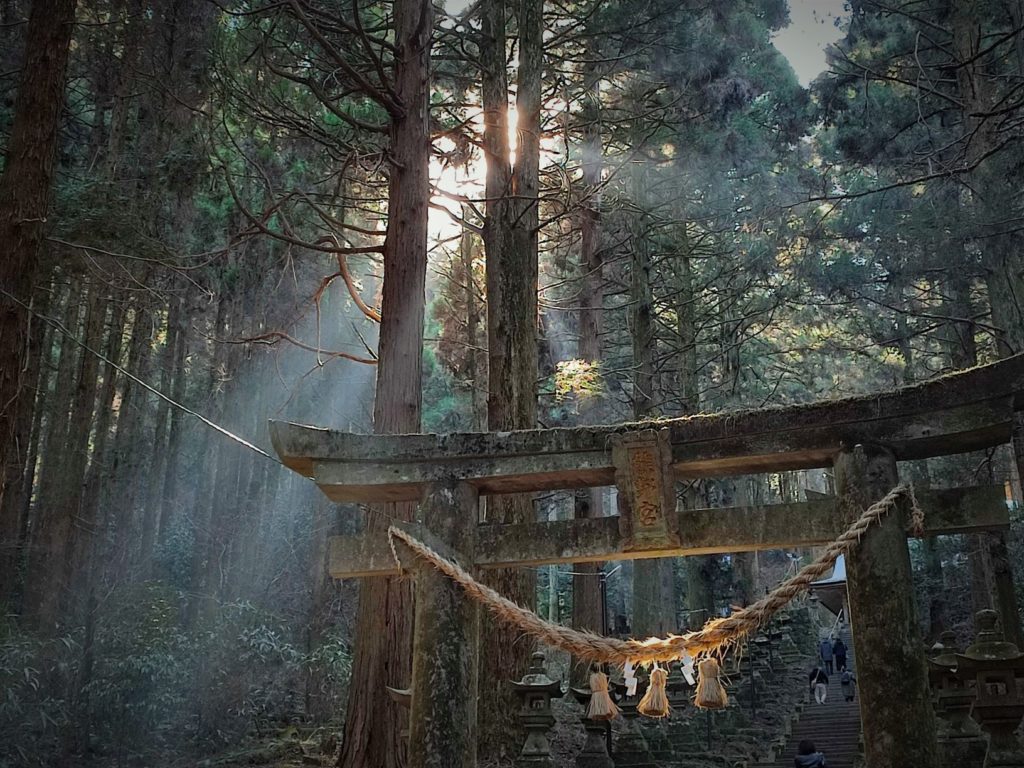
Kamishikimi Kumano-imasu Shrine
If you only have time to visit one shrine in the Aso area, visit the one with the longest name. Kamishikimi Kumano-imasu Shrine is definitely worth the journey even if you’re not a huge fan of shrines. Situated a few kilometres from Takamori Town in Minami Aso, Kumamoto Prefecture, this once little known village shrine has become a social media phenomenon over the last few years and is now one of Kumamoto’s main sights.
What makes it so special?
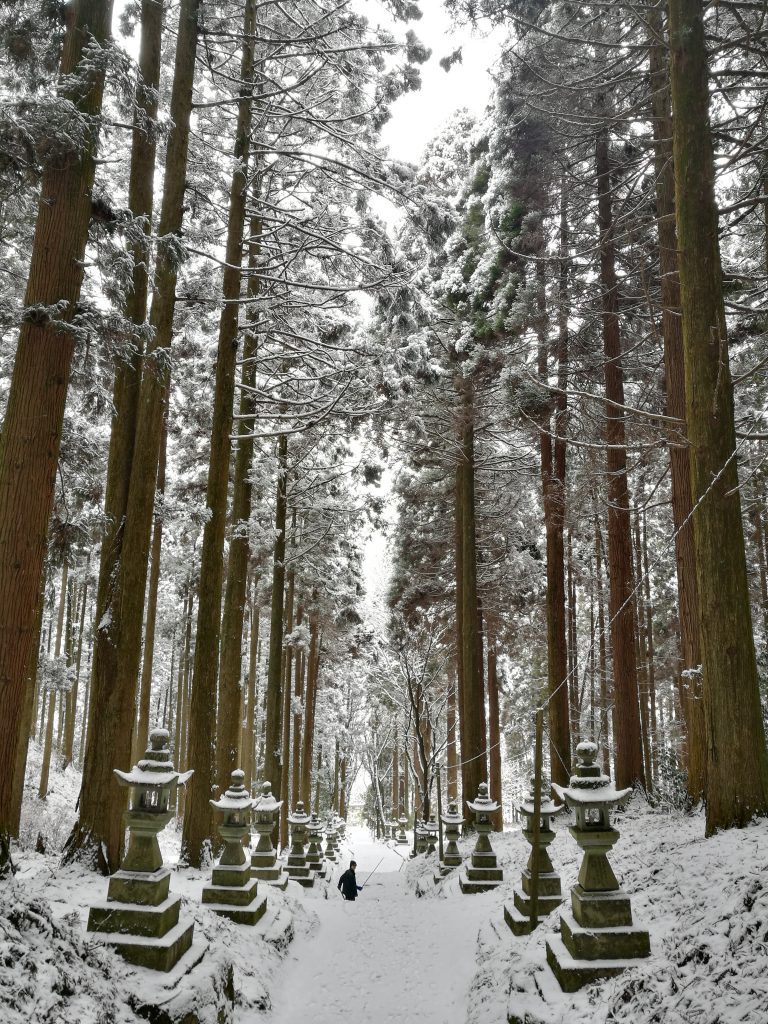
So why is Kamishikimi Kumano-imasu shrine so special? The main attraction is the beautiful setting and the sacred atmosphere you feel walking up a long staircase decorated with moss covered stone lanterns through a cathedral like forest of cedar trees.
At the top of the staircase is a small shrine dedicated to two of Japan’s most important shinto deities. But there is more, look up behind the shrine and in the hillside above you will see a rock archway. This is called Ugetoiwa, if you go through the arch, it is believed that all your goals and ambitions will come true.
Kamishikimi Kumanoimasu Shrine Access Information
- Free
- Large free car park
- Always open
- Toilet half way up
- Entrance is stone steps across from the post office
- Nearest Bus station is Takamori Town, Minami Aso
- Nearest Train Station is Takamori Town, Minami Aso
- 6 km walk from Takamori station
- Rental bicycles from Takamori Tourist Information Center
- Visit Kamishikimi Kumano-imasu Shrine on the Around Aso Tour
Travel tips
- Great place to visit on a rainy day. The colours are more intense, the atmosphere even more special and you might get it all to yourself.
- If the sun is shining, go there in the morning. That’s when you might get the chance to see the sunlight coming through Ugetoiwa archway down the avenue of trees backlighting the torii gate.
- Weekdays are usually pretty quiet.
- Wear sensible shoes.
- There are walking sticks in the car park that anyone can borrow.
- If you are not physically able to walk up or down a lot of steps there is a small road up to the shrine. It runs parallel to the path but it is narrow and steep, with no passing places. At the top there is a parking spot for one car just below the shrine buildings. Across from the main shrine car park you’ll see a small road next to a house, this is the road to take.
- You could easily combine a visit to Kamishikimi Kumanoimasu shrine with a trip to Takachiho Gorge, which is about 45 minutes drive from Takamori town.
- If you are interested in taking a nature walk or learning more about the Aso area. The nearby Minami Aso Visitor Center has walking courses, lots of English information, extensive grounds and many seasonal plants to see.
- There are several restaurants between Takamori town and Kamishikimi Kumanoimasu shrine, but none after it unless you keep driving all the way into the northern side of the caldera.
How to get to Kamishikimi Kumano-imasu Shrine
The shrine is a little difficult to get to without your own transport. From Kumamoto city you can take the Takamori-Go bus to Takamori town. It takes 2 hours from the city and runs via Kumamoto airport 4 times a day. Once you arrive in Takamori the quickest way would be to get a taxi to the shrine which is about 6 km away. You could either ask the driver to wait or come back in an hour to pick you up. Another option is to rent a bicycle from the tourist information or just walk.
Getting to Kamishikimi Kumano-imasu shrine by car
If you are driving, head for Tsukimawari Park or the Minami Aso Visitor Center and then keep going. A few minutes after these spots you will see a small post office on your left. The shrine carpark – a large gravelled space, is just after the post office. Don’t be surprised if you don’t notice the shrine it’s directly across from the post office, just go up the stone staircase and you’re there.
- From Kumamoto Station – 1hr 20 mins
- From Aso Station – about 35 mins
- From Takamori Town – 7 minutes
All you need to know and more about Kamishikimi Kumanoimasu Shrine
The 100 stone lanterns
It is the walk up the 270 or so steps that makes a visit to Kamishikimi so special. You cross the road and enter the first torii gate, the world behind you disappears and you are transported to a green and sacred space. The stairs lead you up through an avenue of tall cedar trees. Along the path 50 pairs of stone lanterns are placed giving the shrine its special atmosphere. About two thirds of the way up there is a green and mossy torii gate, a popular spot for photographers.
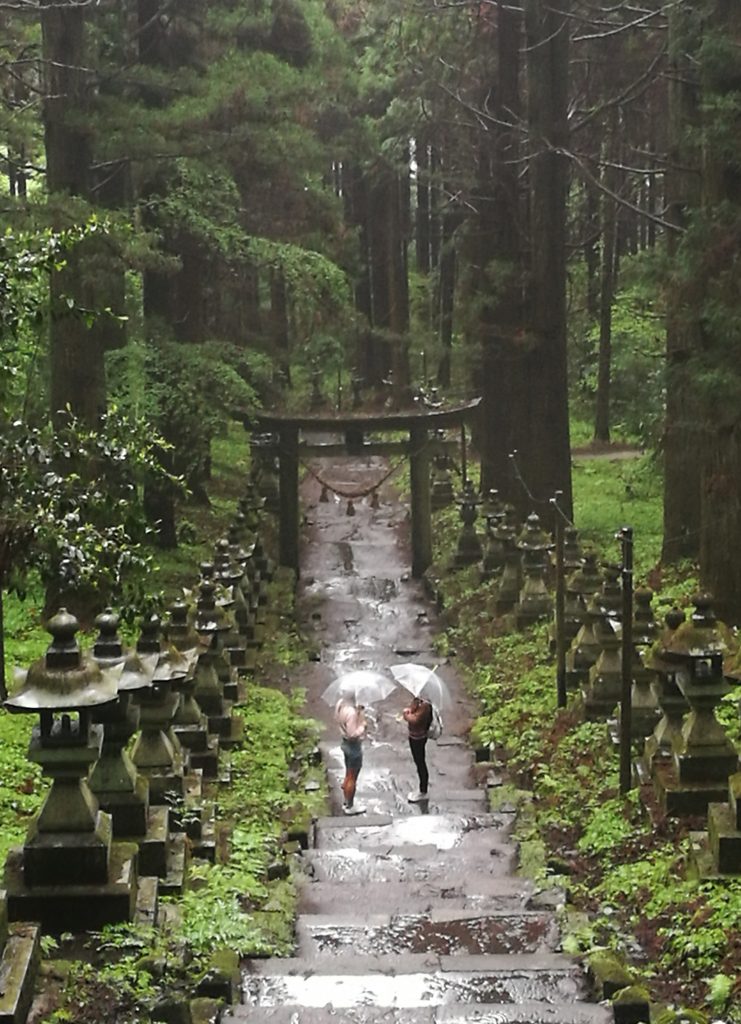
Where did the lanterns come from?
Though the stone lanterns look much older they were all donations from a local business man. Mr Goto, his friends and relatives started donating and placing them there in the mid 1960’s. The most recent one is right at the top erected in 2015. On the back of each lantern is an inscription of the date and occasion. The lanterns are never lit but the picturesque scene they make inspired a Kumamoto animator. She used the shrine as a setting in a popular animated film called Hotarubi no Mori e. (Into the Forest of the Fireflies)
Hotarubi no Mori E Animation and internet fame

In 2002 a Kumamoto animator called Yuki Midorikawa released a manga called Hotarubi no Mori e It was a hit with many readers and in 2011 was made into a short animated film.
The story is of a young girl called Hotaru who spends the summer with her grandparents in the countryside. One day she wanders into the forest alone and gets lost. Luckily a teenage boy wearing a fox mask comes to her rescue helping her find her way home. They become friends and every summer they meet in the forest. As Hotaru becomes a teenager herself she starts to fall for Gin, the mask wearing boy, who never changes or ages. Then she discovers that Gin is actually a forest spirit and their love is doomed…You can watch Hotarubi no Mori e here with English subtitles.
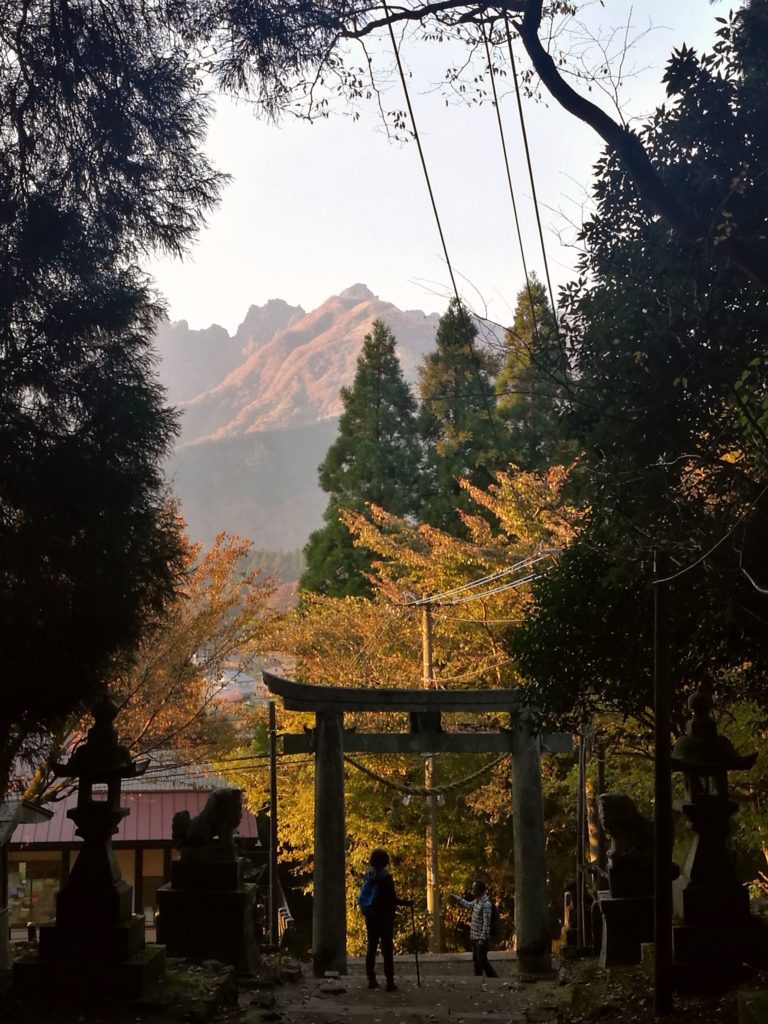
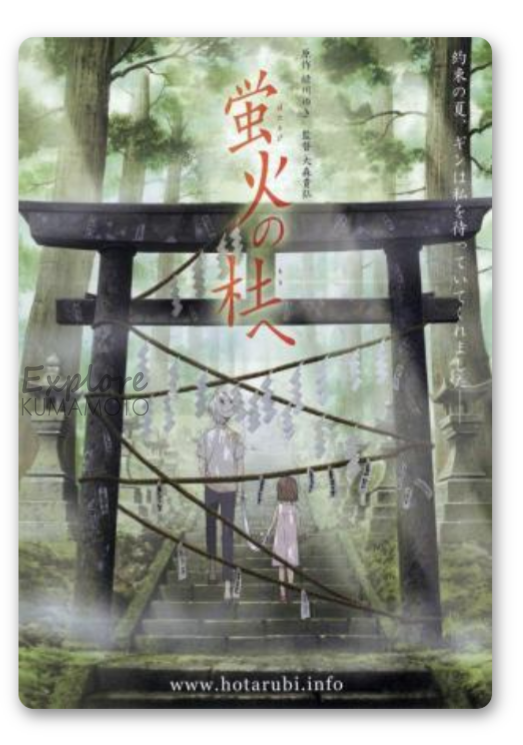
Fans of the animation began to hunt down and visit Kamishikimi Kumanoimasu shrine as a scene location. They then started blogging and posting about it on social media. Photographers also began to find out about it and visit. Many people mentioned its special atmosphere and its reputation as a power spot began. Little by little a snowball effect began. And so the people of Shikimi village discovered that their little known shrine had suddenly become one of Kyushu’s most popular.
Over the last couple of years to cater to the increasing number of visitors, a free car park has been made. The path has also been concreted in places to make it safer and a toilet has been put in about a third of the way up.
History of Kamishikimi Kumano-imasu shrine
Not much is known or written of the origin and roots of Kamishikimi Kumanoimasu shrine. It is one of 3000 Kumano shrines, these originated in the Kumano region of the Kii mountains. This is an area of Wakayama Prefecture, once known as the land of the gods. Interestingly there are 4 Kumano shrines in Aso and all are situated in the Takamori area. The really off the beaten track Shikimi Kumano Imasu Shrine is just a few km from Kamishikimi and also worth a visit if you can find it.

Izanami and Izanagi - the deities of Kamishikimi Kumano Imasu Shrine
If you do any research into Japanese mythology you will quickly come across the names of Izanami and Izanagi. They are the first female and male deities and play a huge role in the founding mythology of Japan.
They were the first Shinto kami to marry and once married they created all the islands of Japan. With that task completed they started populating their new world with more kami.
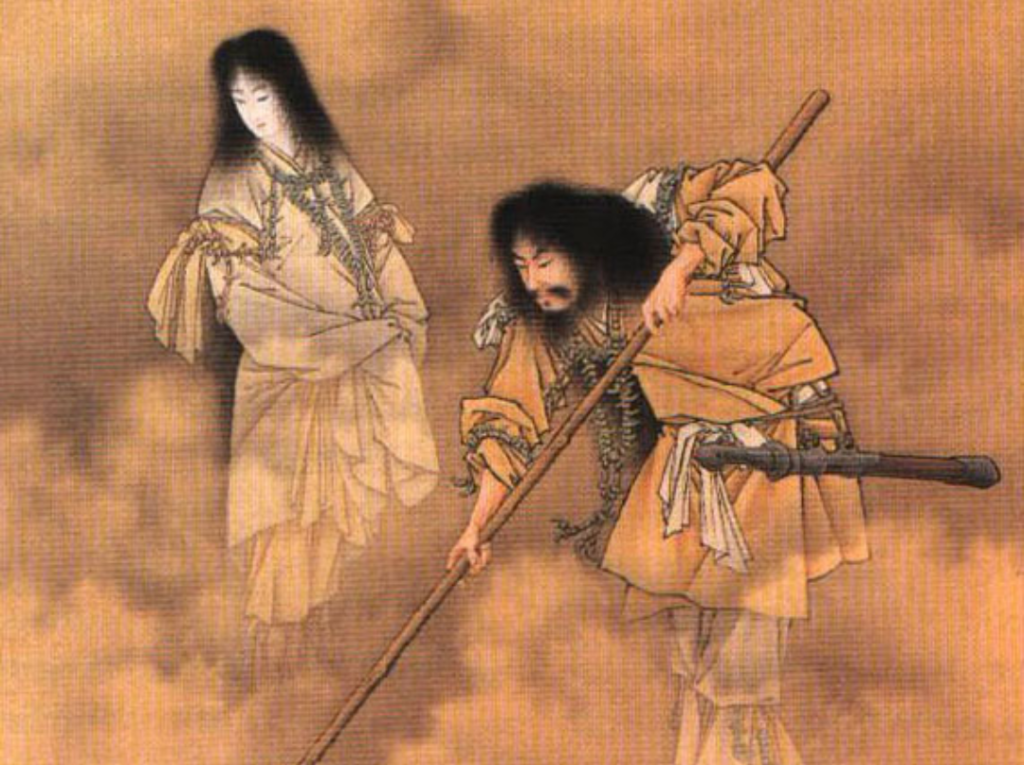
Everything was going well until Izanami gave birth to the kami of fire and tragically died.
Cutting a long story very short her death ended her marriage to Izanagi and she ended up as protector of the land of the dead while her husband stayed and protected the land of the living.
As a side project, and to many this may be their finest achievement, they also invented sake.
Shrines to Izanami and Izanagi often attract people praying for good relationships especially romantic ones.
If you are interested in reading more about Izanami and Izanagi’s story there is a beautiful retelling here by Paul Jordan.
The Nagi Tree - Symbol of the shrine

Izanagi and Izanami’s symbol is a crossed pair of leaves from the Nagi tree (Asian Bayberry). You will find a couple of small Nagi trees on the left and right of the shrine honden (prayer hall). Nagi is an evergreen coniferous tree native to Japan. Leaves from Nagi trees have been used since ancient times in Japanese wedding ceremonies.
Why are they special? Take a look at a leaf from the tree and you will see the veins in the leaf only run vertically. This makes it difficult to tear the leaf in half horizontally, just like it is difficult to break a good marriage. Also if you tear it from the top down it will make 2 perfect halves which fit back together just like the perfect couple. Nagi trees are also closely connected with Kumano shrines. Pilgrims to the Kumano shrines would often take a sprig of Nagi back with them to protect them on their travels, as Nagi was also believed to bring calm conditions.
The Kumano shrine connection
Why are there so many Kumano shrines in one small area?
Historically Takamori was very isolated from other areas in Aso and developed its own local traditions and culture.
Takamori is also famous in Aso for dengaku cooking. This is skewering and cooking a variety of foods around a charcoal fire, the dengaku custom is said to have arrived in Takamori in the Edo era. Locals brought the custom of dengaku back after visiting Kyoto and Izumo where it was a popular method of cooking. The Kumano shrines are in the same area of Honshu so one theory is that locals also visited the famous Kumano shrines there. Then returning to Takamori created their own Kumano shrines or renamed existing ones.
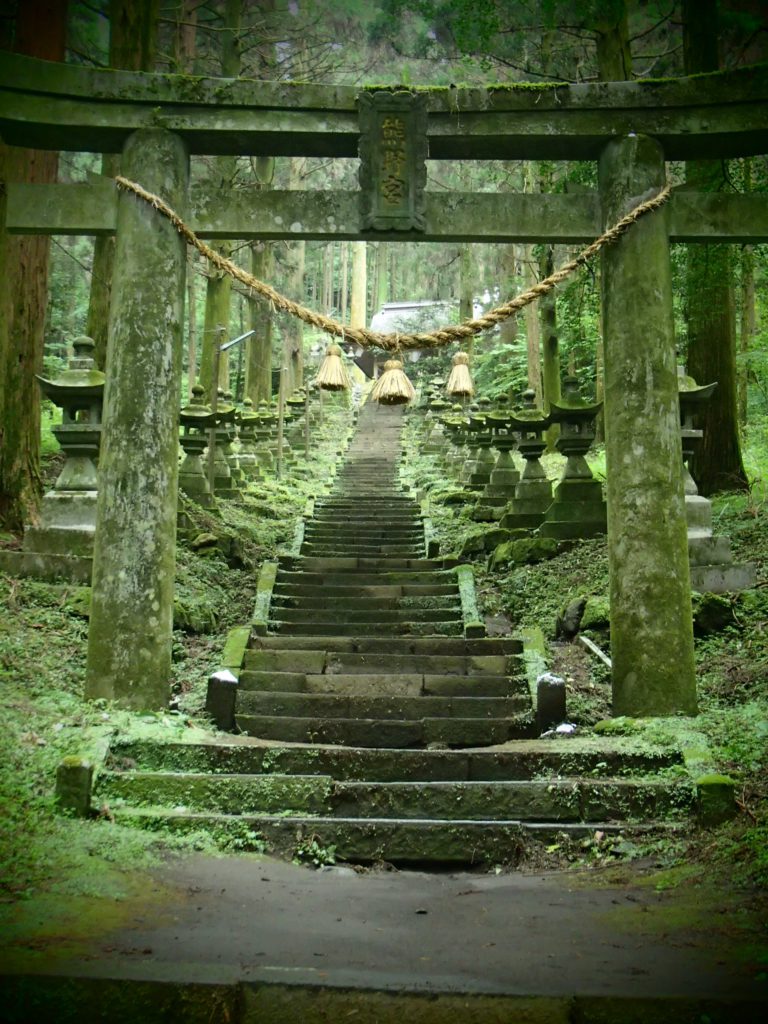

The shrine buildings and Ugetoiwa wind hole
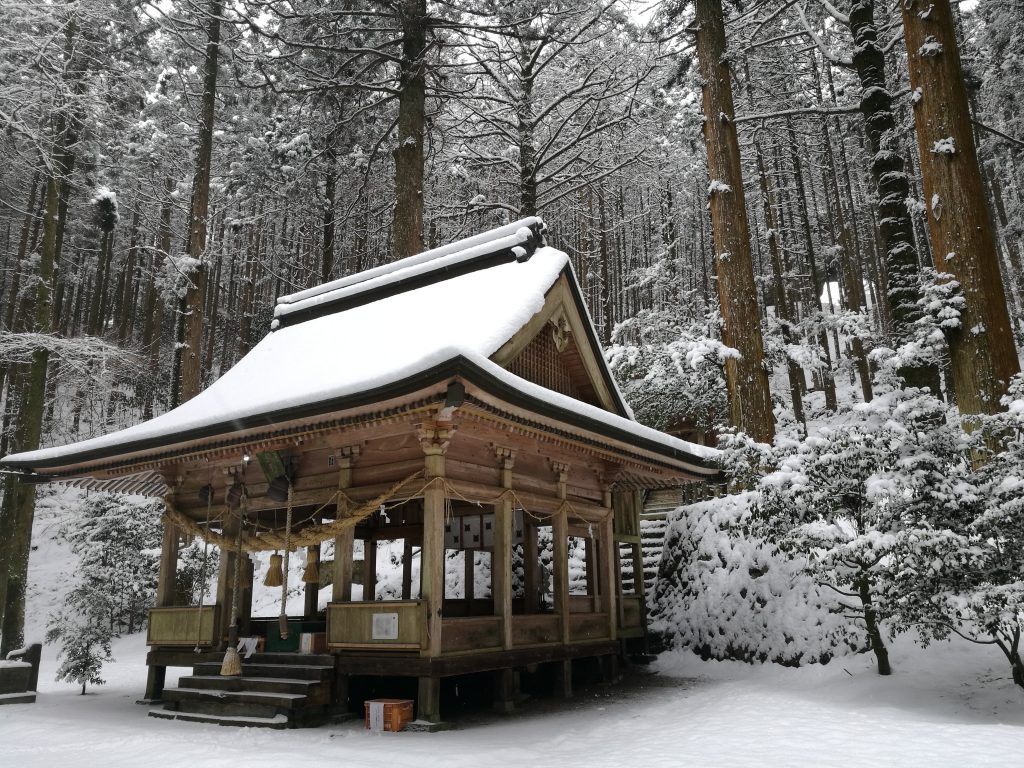
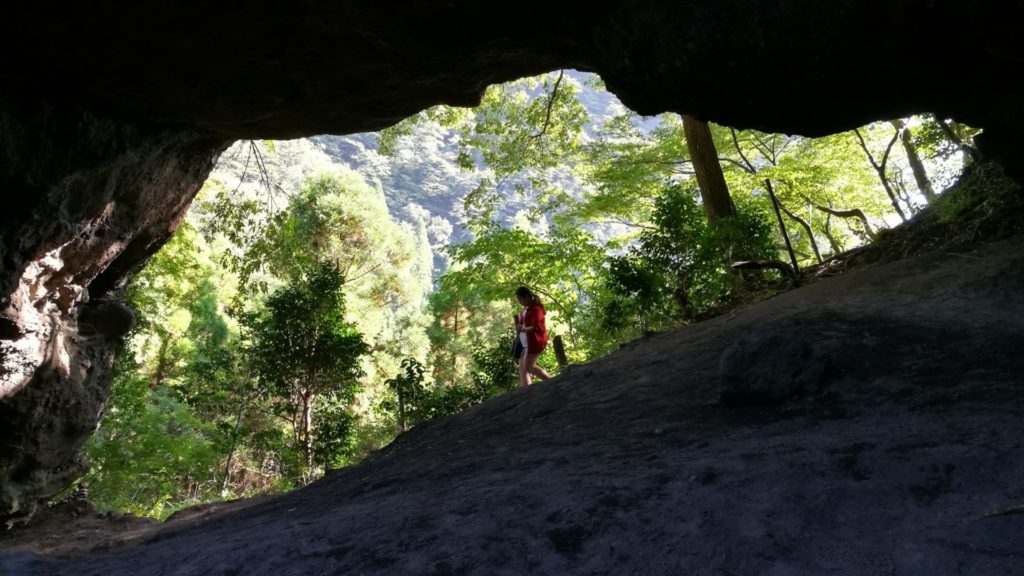
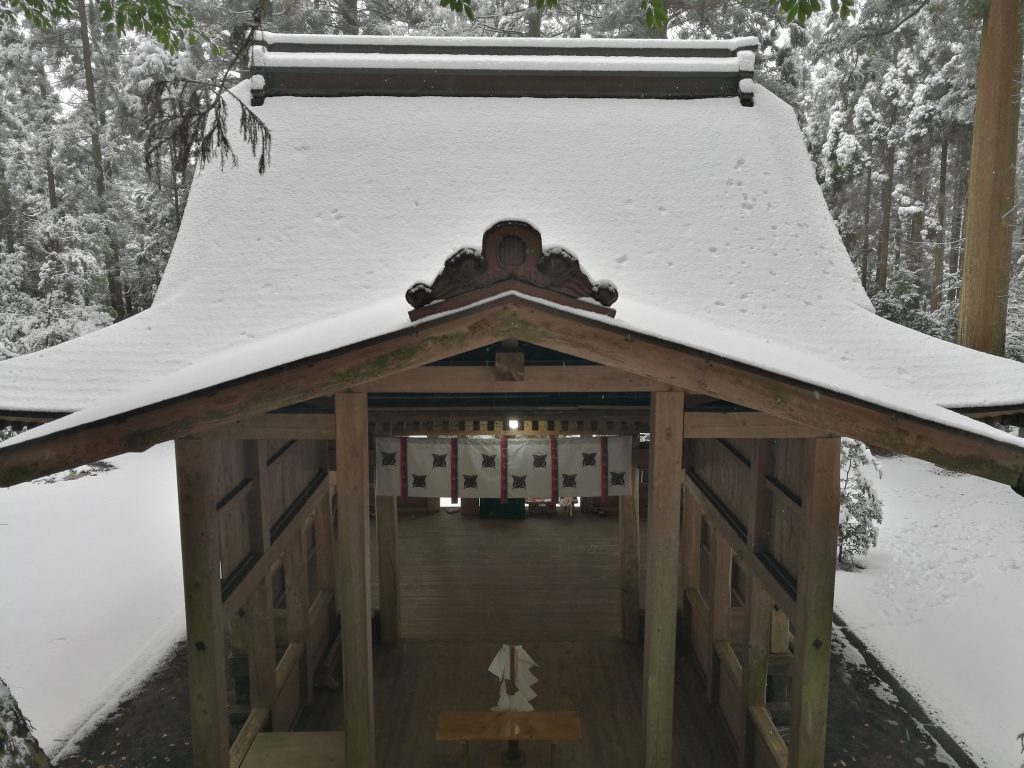
The current shrine building is known to date back to 1722, after the previous building was destroyed by fire. Whether it was a Kumano shrine before the Edo era or not is unknown. What is clear that this location has been venerated since ancient times. This is due to its special geological feature; the large windhole above the shrine. Shrines often venerate natural features such as this. In fact as you walk up the path to Ugetoiwa you will pass an ancient burial mound dating back around 1500 years. This wind hole is also connected to a legend concerning the principal Aso deity and a demon named Kihachi.
Tateiwatatsu no mikoto is the main deity of Aso. He is an odd composite of the grandson of Japan’s first emperor who became the founding father of the Aso region and the spirit of the Aso volcano itself. Indeed the Aso local legends suggest he had quite a fiery temper
Kamishikimi - The Legend of Ugetoiwa
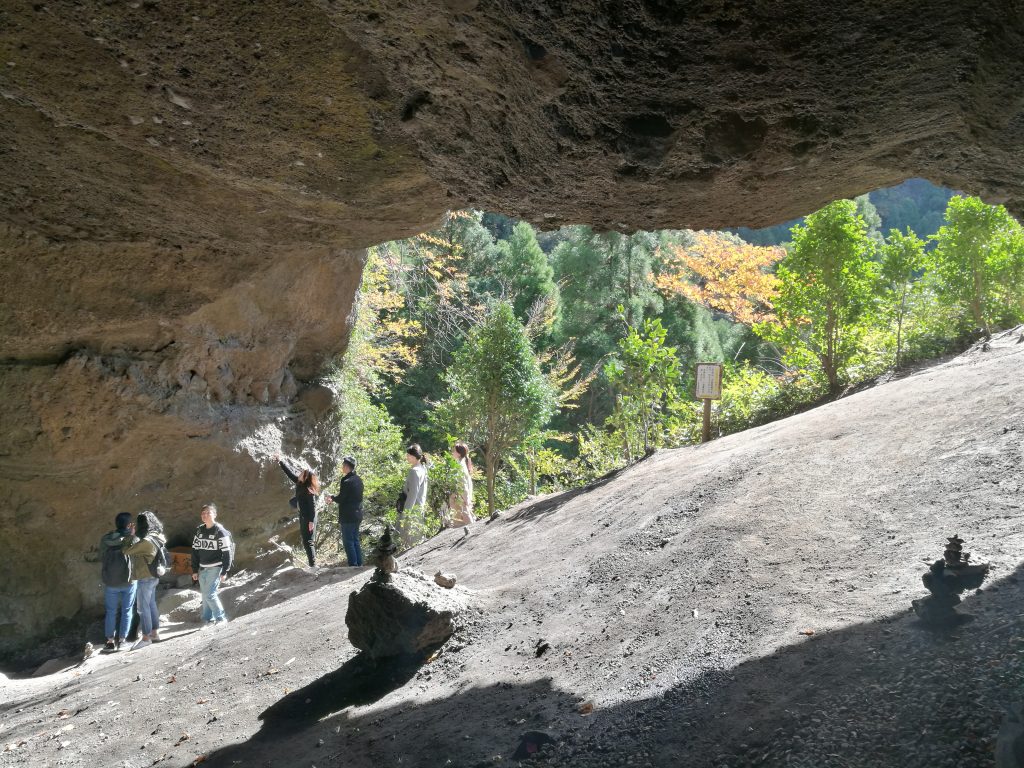
One day Tateiwatatsu no mikoto was sitting on one of the peaks of Mount Aso practising his archery. Again and again he aimed and shot his single arrow at a rock on the far side of the northern caldera edge. (This rock exists and is called Matoishi – meaning the target rock). Each time, his faithful servant Kihachi would run across the caldera and fetch the fallen arrow back to his master. However, on the hundredth time Kihachi became tired and instead of picking up the arrow and courteously carrying it back he roughly kicked it. This insult made Tateiwatatsu No Mikoto volcanic with rage and he chased Kihachi all the way around the caldera. Kihachi turned into a demon and attempted to get out of the caldera punching and kicking several holes in the caldera edge. Finally he kicked through Mount Tsukigata forming Ugetoiwa, the largest windhole. As he tried to escape through the hole Tateiwatatsu No Mikoto caught him, dragged him back inside and cut him in to pieces …..

and no the story doesn’t end there… But you’ll just have to come on an Around Aso tour to find out what happened next ..
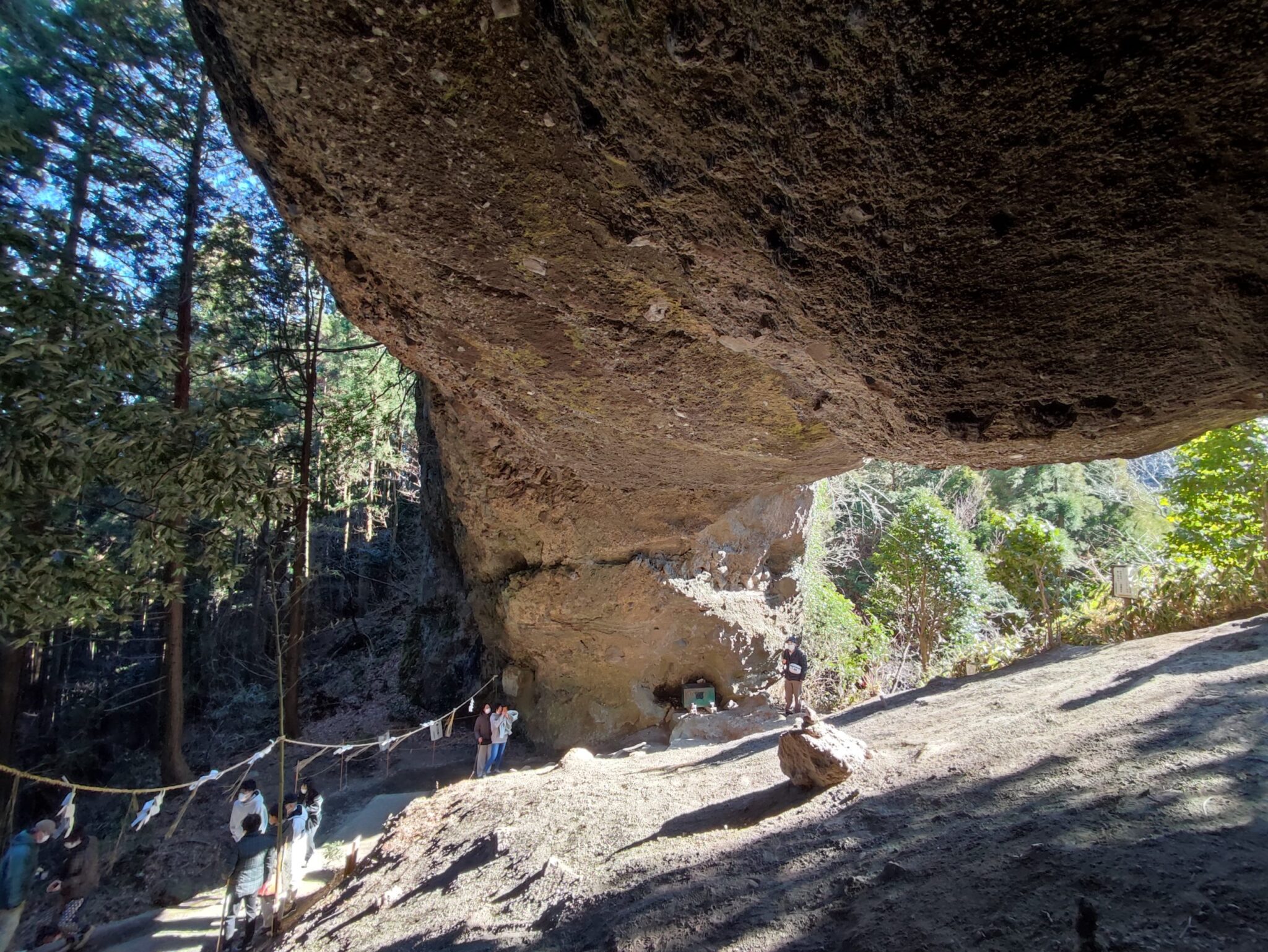
Visiting the rock arch Ugetoiwa
Walking up to the rock arch has become a tradition associated with achieving your target in life. Until several years ago the walk up to the arch was a challenge going straight up the steep and slippery hillside. Nowadays there is a concrete path which winds up the hillside and it takes less than 10 minutes to reach the archway. At the base of the path on the right side of the shrine there are bamboo walking sticks for anyone to use. It’s worth taking one as once you are inside the arch the ground can be quite loose and slippy.
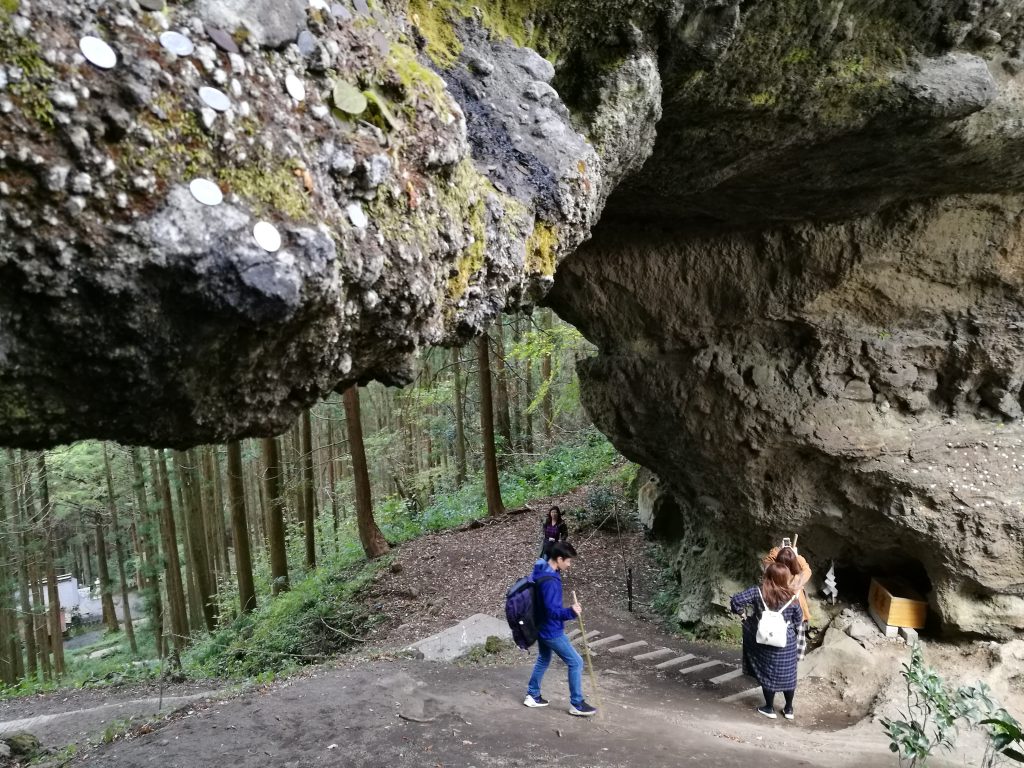
If you don’t want to go all the way up to Ugetoiwa but do have an ambition to pray for, don’t worry there is a shortcut. Keep a look out as you are walking up the path to the shrine just before the green Tori gate. On the left of the path you will see a large moss covered rock, it almost resembles a tree stump. There is usually a shimenawa – sacred rope around it and a scattering of coins on top. This rock is said to have fallen when Kihachi kicked the hole through the mountain so this is also a place where your prayers can be answered.
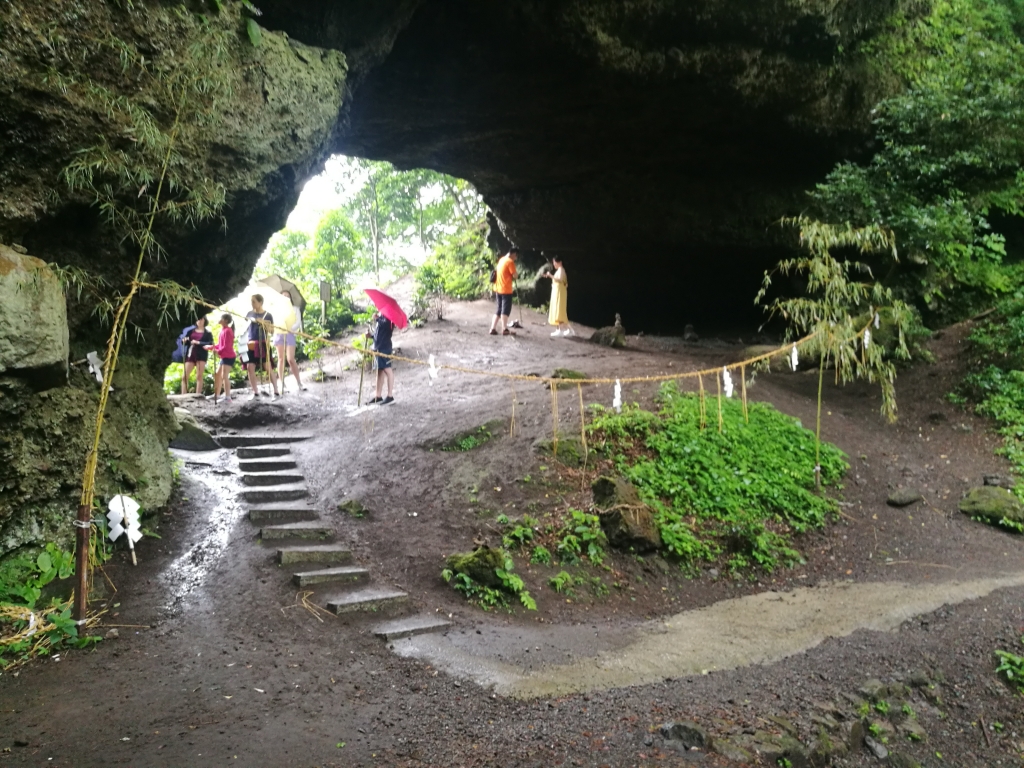
You will also see a shimenawa (sacred rope) across the entrance to the Ugetoiwa wind hole. You can enter the archway and walk through to the other side. It is custom to touch the rock archway and then make a prayer or wish. People will take a coin with them to pray here for whatever ambitions or targets they have in their life. You can leave the coin in the collection box or some people like to throw it to land on one of the rocky ledges. Other people make small piles of rocks and leave them in the arch as a wish or prayer.
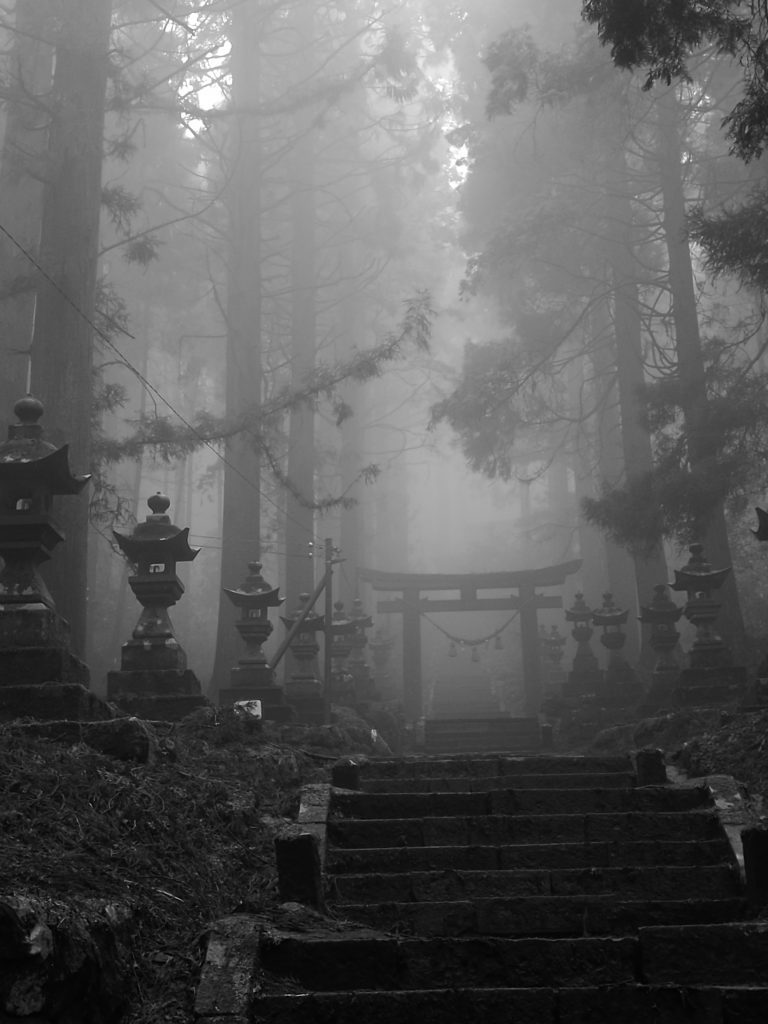


Places to visit near Kamishikimi Kumanoimasu Shrine
- Shirakawa Spring
- Tsukimawari Park
- Minami Aso Visitor Center
- Asobonosato Kugino
- Takamori Yusui Tunnel
- Nakadake Volcano
- Takachiho Gorge
